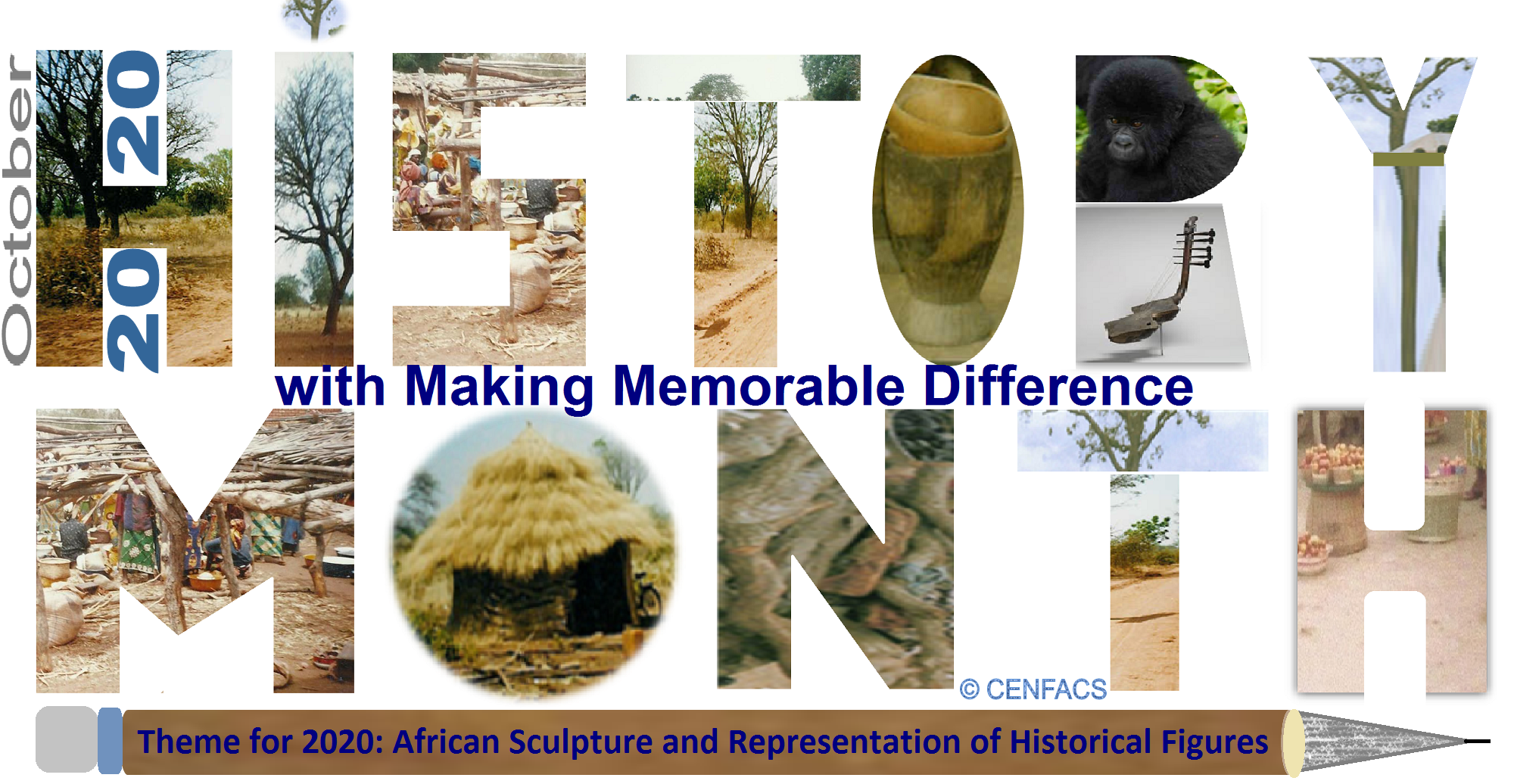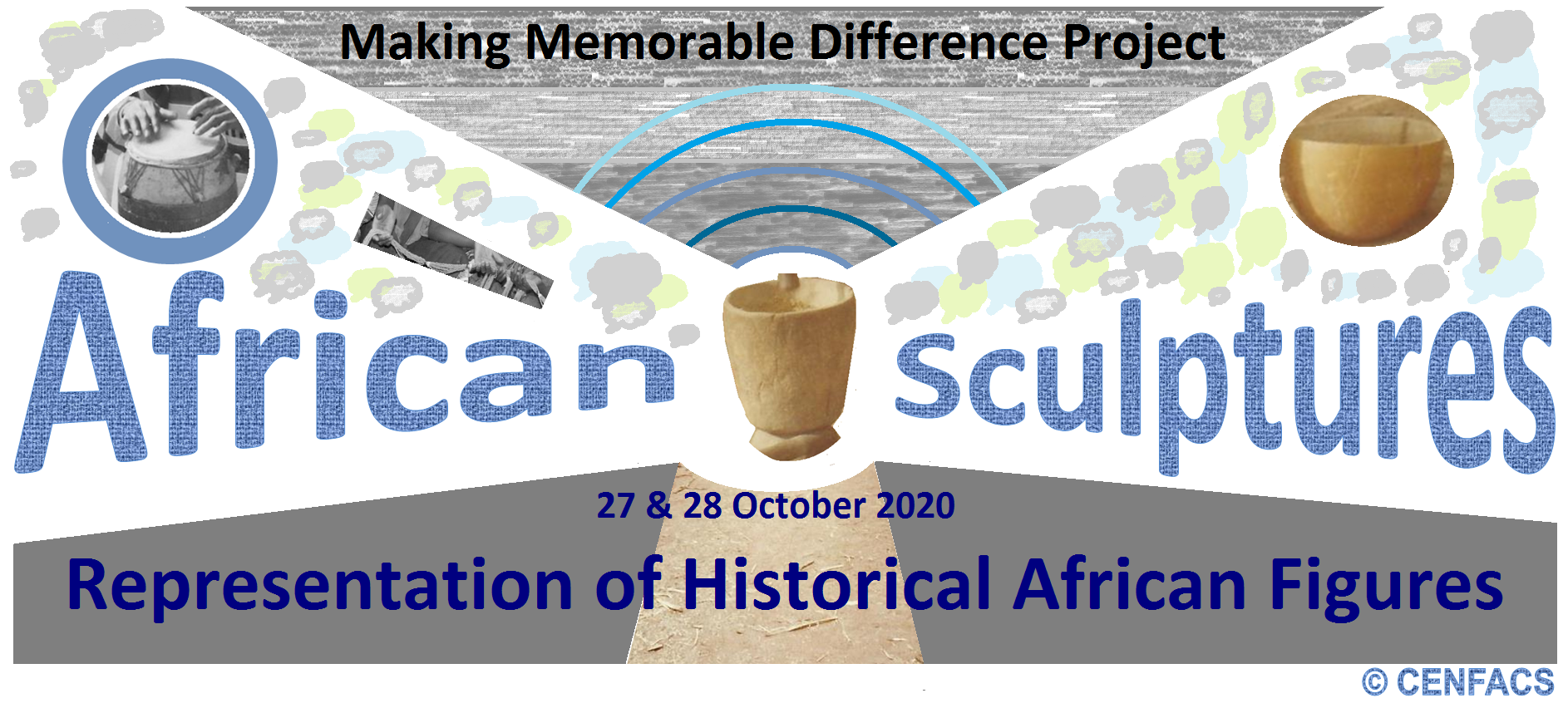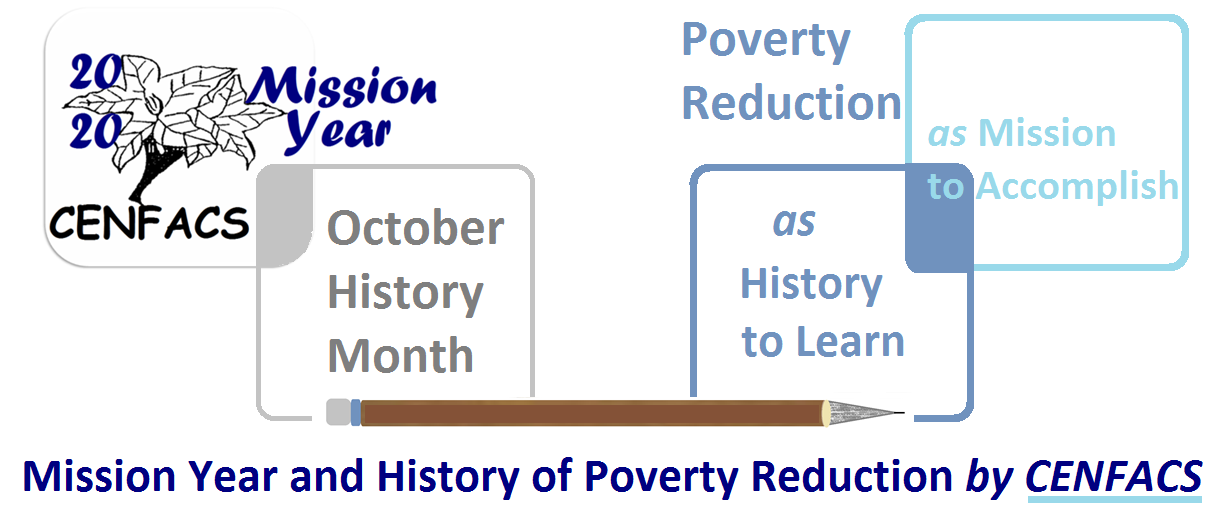Welcome to CENFACS’ Online Diary!
07 October 2020
Post No. 164
The Week’s Contents
• History Month with Making Memorable Difference Project – In Focus: African Sculpture and Representation of African Historical Figures of the Pre-independence Era
• “A la une” (Autumn Leaves of Action for the Upkeep of the Nature) Campaign with Special Attention to Restoration of Ecological Infrastructure in Africa
• Just Been Launched: Autumn 2020 Humanitarian Relief Appeal in the Period of a Post-pandemic Recovery
… and much more!
Key Messages
· History Month with Making Memorable Difference Project – In Focus: African Sculpture and Representation of African Historical Figures of the Pre-independence Era
This week, the lead story line of poverty relief and sustainable development at CENFACS is about Making Memorable Difference in October. October is the History month in CENFACS development calendar. We normally remember the African history through Making Memorable Difference (MMD) project.
This year’s MMD, which is the 12th one, is about African Sculpture and Representation of African Historical Figures of the Pre-independence Era (period before the 1960s).
The 12th MMD or MMD 2020 will be about acknowledging African Legacies in terms of carving or modelling skills to represent in human form historically well-known African people; people known for their historical contribution to Africa.
Since our work is about poverty reduction, MMD 2020 will focus on those types of African sculptures that represent those who showed exceptional talents in helping others to come out poverty during the pre-independence epoch. We shall extend our interest to those who are drawing inspiration from these sculptural legacies in order reduce poverty in today’s world.
Because of the coronavirus outbreak and its spikes, the 12th MMD Event of two days of work will be held virtually. Like everybody, we are required to follow Covid-19 restrictions and social distancing rules to protect ourselves, the CENFACS Community and the public health.
For further information on this acknowledgement, read under the Main Development section of this post.
Besides the main history theme of October, we are also running our environmental campaign “A la une” as planned.
• “A la une” (Autumn Leaves of Action for the Upkeep of the Nature) Campaign with Special Attention to Restoration of Ecological Infrastructure in Africa
“A la une” campaign has already started with our work on the GREAT BEASTS and the “Blue Spaces” theme. During these October and November 2020, we shall continue these two areas of advocacy while dealing with our work on Sustainable Trajectories for the Nature where we left it. In this campaign about the upkeep of the nature, we shall pay a special attention to Restoration of Ecological Infrastructure in Africa.
Restoration comes at the right moment since we are dealing with the process of building back better Africa from the coronavirus pandemic disaster. Restoration is also part of the Rehabilitation Strategies making the third phase of our Covid-19 Campaign, a Campaign for Resilience against the Coronavirus Pandemic.
As we mentioned it in our previous communications, in the process of building back better Africa, one should not forget flora and fauna. Likewise, one should not leave behind ecological infrastructure in Africa.
Furthermore, last year we were in a situation of urgency of taking a bold climate action to keep under control the trajectories of rising temperature. This year, there is a new urgency brought by the health crisis with the coronavirus pandemic. This new urgency has been added to the last year’s one as the climate urgency has not been yet resolved.
Because of these two urgencies, our work on the nature will take on board both of them. By taking into account the two of them, we shall include the dilemma about how to help meet life-sustaining needs while handling life-threatening impacts of climate change and Covid-19. In this respect, “A la une” campaign will integrate life-sustenance and life-treat.
An outline of the contents of Restoration work that will make this year’s “A la une” campaign will be given in our future communication.
For any more information about this year’s “A la une” campaign, please contact CENFACS and or continue to read our posts over this Autumn season.
Before closing this chapter about “A la une”, we would like to just let you know that the environmental campaign known as “A la une” and humanitarian appeal are both part of our Autumn programme.
• Just Been Launched: Autumn 2020 Humanitarian Relief Appeal in the Period of a Post-pandemic Recovery
The 2020 Edition of Autumn Humanitarian Relief Appeal is now live on the page Support Us at cenfacs.org.uk/support-us/
This appeal is about improving the quality of poor people’s lives and welfare by helping them to help themselves. It is also about enhancing the quality of protection for the nature.
This appeal is not an ordinary humanitarian relief request like the one we launch every autumnal season. It is an extraordinary one dealing with the problems that poor people, organisations and wildlife are facing in the contexts of life-threatening and destroying impacts of the coronavirus in a post-pandemic recovery period. For people who are already poor and wildlife that has been continuously threatened, the current contexts of Covid-19 threat and economic restructuring make life even more difficult for them compared to other contexts.
In launching this appeal, we are mindful of the current difficult global health and economic contexts in which many of our supporters are. Due to these conditions, the ability of many of them to support good and deserving causes has been reduced. For those who can support, we are imploring to them to do something in the forms of donation, gift aid and other helpful support.
You can …
√ donate £2 to create 2 benefits (1 benefit for humans and 1 benefit for other natural livings) or any amount starting from £2 or more as you wish,
√ gift aid your giving,
√ and support these projects in a way that is the most suitable and related to your situation, capacity and willingness.
Support has no limits at CENFACS. You can donate as much as you can.
To donate, gift aid and support otherwise to help poor people, flora, fauna, communities and organisations in Africa; please contact CENFACS at cenfacs.org.uk/support-us/.
Extra Messages
• Crossing the Line of Extreme Poverty for the First Time
As part of the implementation process of Goal 2 of our 2020s Poverty Reduction Programme and Development Agenda, we are dealing with the number of people who have crossed the line of extreme poverty for the first time, in particular the line of extreme consumption poverty.
Before going further, let us explain extreme poverty. The United Nations (1) defines extreme poverty as
“a condition characterized by severe deprivation of basic human needs including food, safe drinking water, sanitation facilities, health, shelter, education and information. It depends not only on income but also on access to services”.
During any severe crisis, it happens that many people and or families can be forced to cross the line of extreme poverty as defined above. For those who are already poor and/or have experienced extreme poverty before, they know what is like to be extremely poor. They know the struggle to pay for or access food, energy, water, health, housing, education, information, transport, equal rights, etc.
This week, we are dealing with the poverty elements of Goal 2 since the coronavirus pandemic and subsequent lockdowns have push many people and families to the edge or to cross the line of extreme poverty. They have added health and personal hygiene costs (such as the costs of buying personal protective equipment, sanitisation and disinfection products as well as the cost of cleaning) to their normal expenses budget. In doing so, these events have perhaps created new poor and or are holding the existing poor still poor.
If you did cross the line of extreme poverty for the first time to move to full extreme poverty area, we would like to hear your experience of crossing the line of extreme poverty for the first time.
To share your experience of crossing the line of extreme poverty for the first time, just contact CENFACS.
(1) United Nations, 1995: The UN 1995 Report of the World Summit for Social Development
• Covid-19 History and Poverty History
It may be too earlier to talk about the history of the Covid-19 since this type of virus in a family of coronaviruses has just been known recently. In fact, researches have been still conducted to understand the nature and pattern of Covid-19. However, as part of the October History Month and due to the continuation of battle against Covid-19, we are doing some history learning and development about it.
We are studying the evolution of the epidemiological (epi-curves) curves of the Covid-19 since its outbreak, and its implications for and consequences on poverty and poverty reduction. We will be looking at the evolution of poverty since Covid-19 outbreak began to see if there could be any correlation between the epi-curves of Covid-19 and poverty curves in the specific area of our operation in Africa.
This kind of work requires reliable data as well as good methodology and modelling technics (e.g. quantitative or statistical ones like econometrics). If anyone is doing similar study or research within the community, it will be a good idea to share these findings with CENFACS.
For further details about Covid-19 History and Poverty History, please contact CENFACS.
• Mission Year and History Month
Our Mission Year continues in this October 2020 of history learning and development. Likewise, the projet dealing with the Mission Year is still being implemented. As part of this implementation process, we are applying this projet to the History Month.
Indeed, besides our Making Memorable Difference Project with its 2020 focus on African Sculptures and Representation of African Historical Figures, we are carrying on to learn the history of poverty reduction and sustainable development in Africa. This history learning and development echoes our Mission Year and Project.
CENFACS’ Mission Year and Project is about embarking on poverty reduction charitable endeavour by working with and being on the side of those who are poor, especially at this exceptional time of the coronavirus pandemic and economic uncertainty.
One can attempt to draw from the above that there could be a link between the contents and activities of our Mission Year/Project on the one hand and our desire to continue to learn and develop from the history of poverty reduction in Africa on the other. There is an area of intersection between the activities of Mission Year/Project and those of History Month. There is an area of common interest between our poverty reduction mission on the one hand and poverty reduction through African sculptures and the representation of African historical figures of the pre-independence era on the other.
Briefly, poverty reduction can be looked at as a mission to accomplish and as a history subject to learn and develop.
To discuss and or enquire about CENFACS’ Mission Year/Project and History Month, please contact CENFACS.
Main Development
• History Month with Making Memorable Difference Project – In Focus: African Sculpture and Representation of African Historical Figures of the Pre-independence Era (i.e. Period before the 1960s)
• • What is MMD?
MMD is
∼ a two-day event of Awareness, Thought and Recognition set up by CENFACS in 2009 to celebrate the Black History Month in our own way and feeling while preserving the tradition linked to this remembrance and standing on the shoulders of similar celebrations
∼ a historic project of collective memory about works carried out, heritage and legacies left by Africans
∼ all about collectively telling, acknowledging, studying and learning that every day Africans wherever they are (in Africa) or elsewhere (in the UK-Croydon and the world) are striving to improve the quality of their lives and of others. Through their historically valuable works, they are making memorable difference and the world a better place for everybody, including the generations to come.
∼ a celebration of African Abilities, Talents, Skills and Gifts to Africa and the world.
This year’s dedicated two days (27 and 28 October 2020) are virtual days of historical study, analysis and skill recognition and celebration of the legacies left by Africans in Sculpture and Representation of Historical Figures.
So, our sharing and engaging content this October is on how the carving and modelling skills, abilities and knowledge of Africans helped in representing historical figures, while reducing poverty and enhancing sustainable development.
• • Two Virtual Days of African History: One Day for Sculptures and One Day for Representation of Historical Figures
Understanding Day (27 October 2020): Understanding of African Sculptures
In the first day of MMD will be about looking at how the art or act of carving or modelling with clay, wood, stone, plaster, etc. has so far helped in understanding African history and in relieving people from poverty and hardships. During this virtual day, we shall look at some examples or patterns of sculptural work done by African sculptors while trying to identify or pick up any messages of poverty reduction in some of these historical works.
Legacies and Gifts Day (28 October 2020): Representation of Historical Figures of the Pre-independence Era (i.e. period before the 1960s)
During the Legacies and Gifts Day of MMD, we shall deal with the best sustainable and non- conflicting way of representing Historical African Figures of the Pre-independence Era (i.e. a period before the 1960s).
This treatment of African history will be done in a way that avoids or minimises conflicts between previous and future generations, between the past and current worlds. In other words, efforts will be made to find ways of best representing African historical figures while avoiding conflicts between generations, between ethnic groups, between civilisations. In doing so, we shall try to build bridges between generations.
Briefly, the overall purpose of the MMD materials from African Sculpture and Figures Representation will be to extirpate the historical legacies and foundations in terms of poverty reduction and sustainable development in Africa. They will be about finding out sculptural messages about how African sculpture and figures representation have helped to reduce poverty and enhance sustainable development during the above defined era.
To engage with this year’s MMD theme and or support this project, please contact CENFACS on this site.
• • Making Memorable Difference Timeline
2009: CENFACS recognised environmental sustainability.
2010: We acknowledged and honoured sports contributions and history in relieving collective poverty and improving community lives beyond fitness and beyond individualistic achievements.
2011: We recollected, remembered and revered caregiving talents and legacies of young carers in enhancing human development (their own development and other people’s development) by reducing the burden of poverty.
2012: We dedicated our historical recognition to Africa’s Global Game Runners and the Science of Running.
2013: Our two days were about the Memorable Difference Made and brought by Working Poor (Miners & Factory Workers) in relieving poverty. We consecrated them to the historical study of The Role of Working Poor Miners and Factory Workers of Natural Resources and Extractive Industries in the Poverty Relief in Africa since the Berlin Conference (1884-5).
2014: We celebrated the place of the African Music and Dance in the pre– and post-colonial eras, the late 1950s and the early 1960s. This celebration focused on the African History of Singing and Dancing and their Impacts on Liberation and Freedoms.
2015: Making Memorable Difference focused on African Negotiators of the History.
2016: We remembered the Protectors and Guardians of the African History and Heritage.
2017: We acknowledged the Communicators of the African History
2018: We learnt about African Communications and Oral History
2019: We searched on the African Health History
For further details about these past MMD events, please contact CENFACS.
Help CENFACS keep the Poverty Relief work going in 2020.
We do our work on a very small budget and on a voluntary basis. Making a donation will show us you value our work and support CENFACS’ work, which is currently offered as a free service.
One could consider a recurring donation to CENFACS in the future.
Donate to support CENFACS!
FOR ONLY £1, YOU CAN SUPPORT CENFACS AND CENFACS’ PROJECTS, JUST GO TO http://cenfacs.org.uk/supporting-us/
Thank you for visiting CENFACS website and reading this post.
Thank you as well to those who made or make comments about our weekly posts.
We look forward to receiving your regular visits and continuing support throughout 2020 and beyond.
With many thanks.








